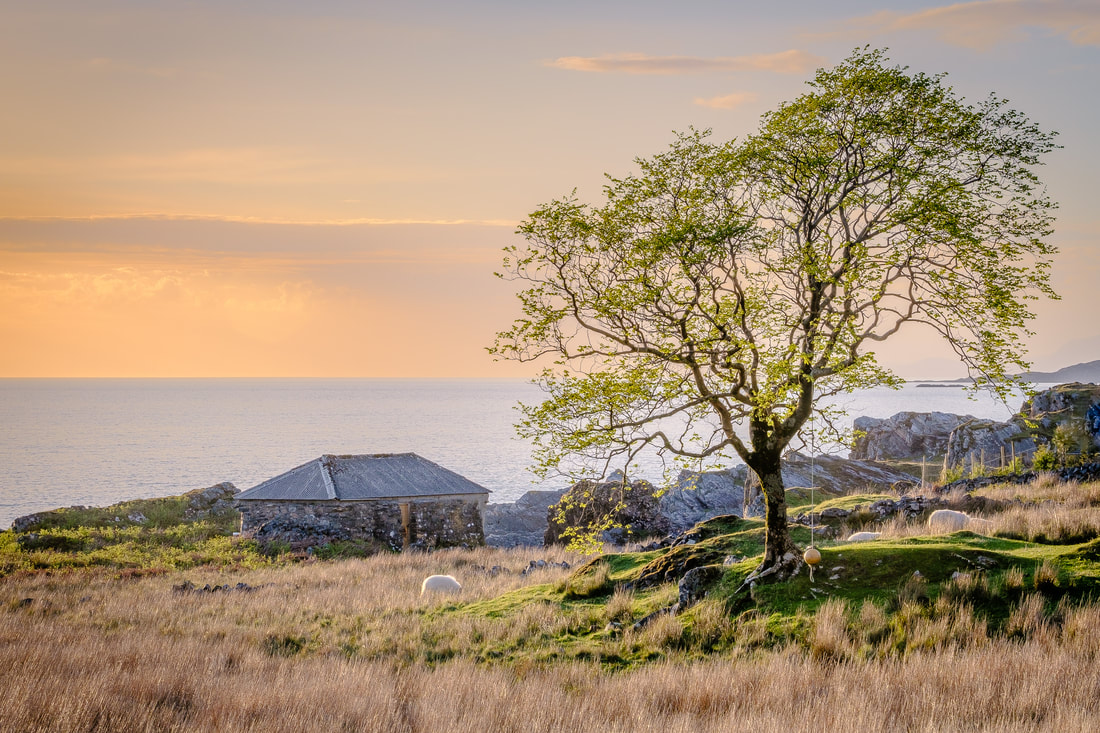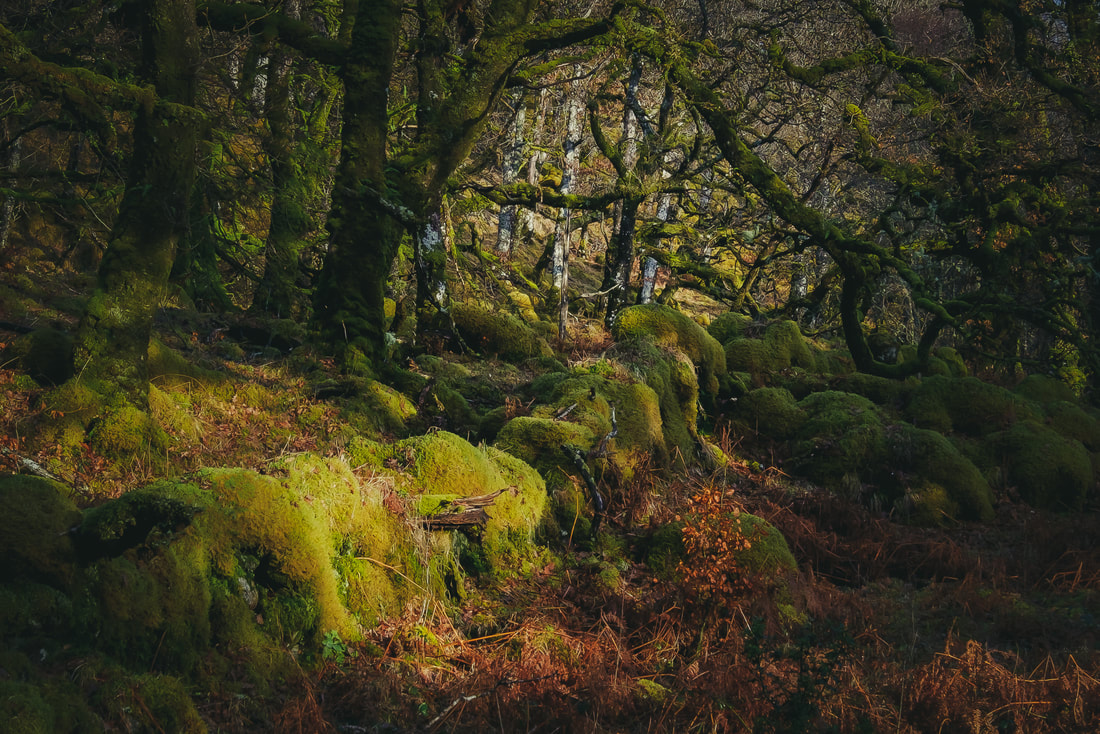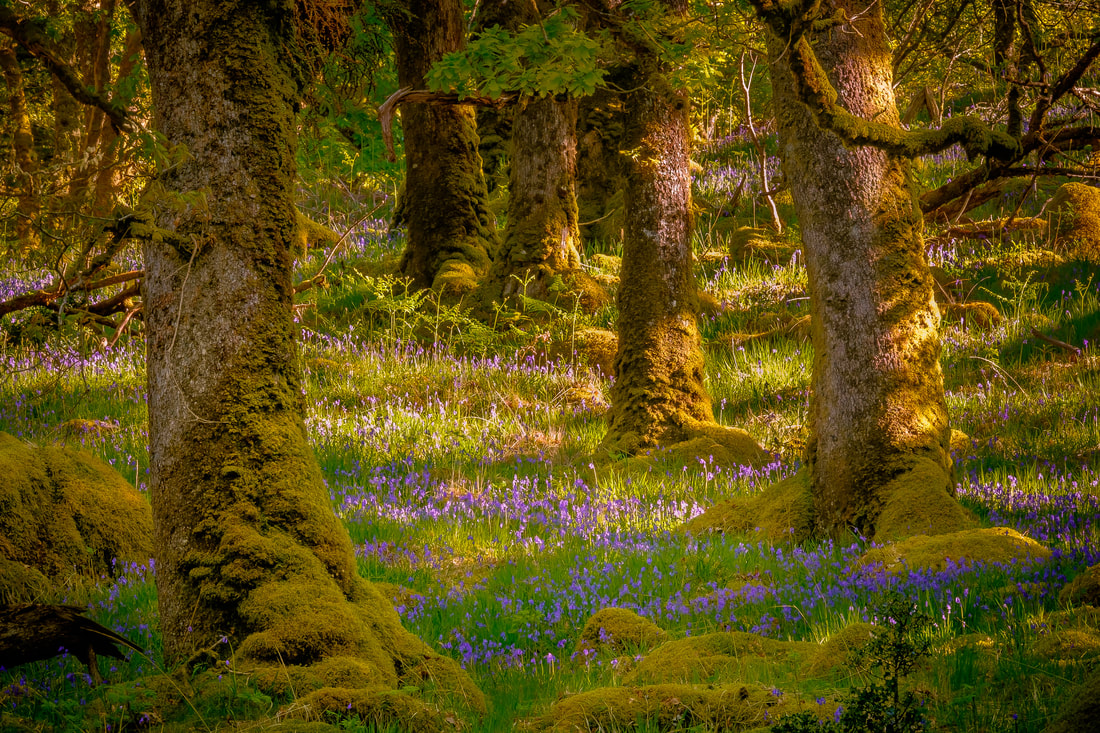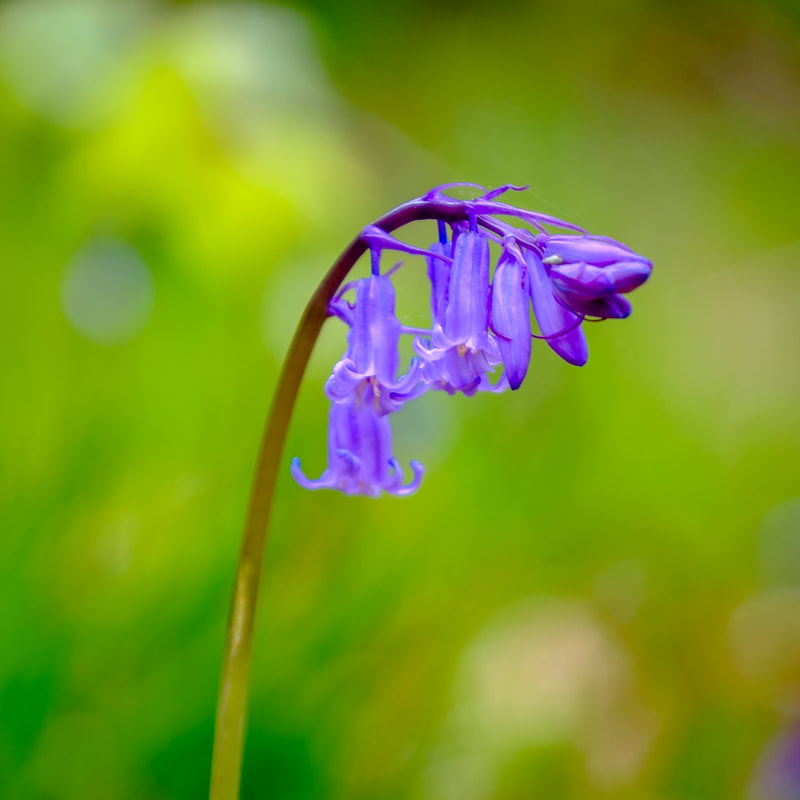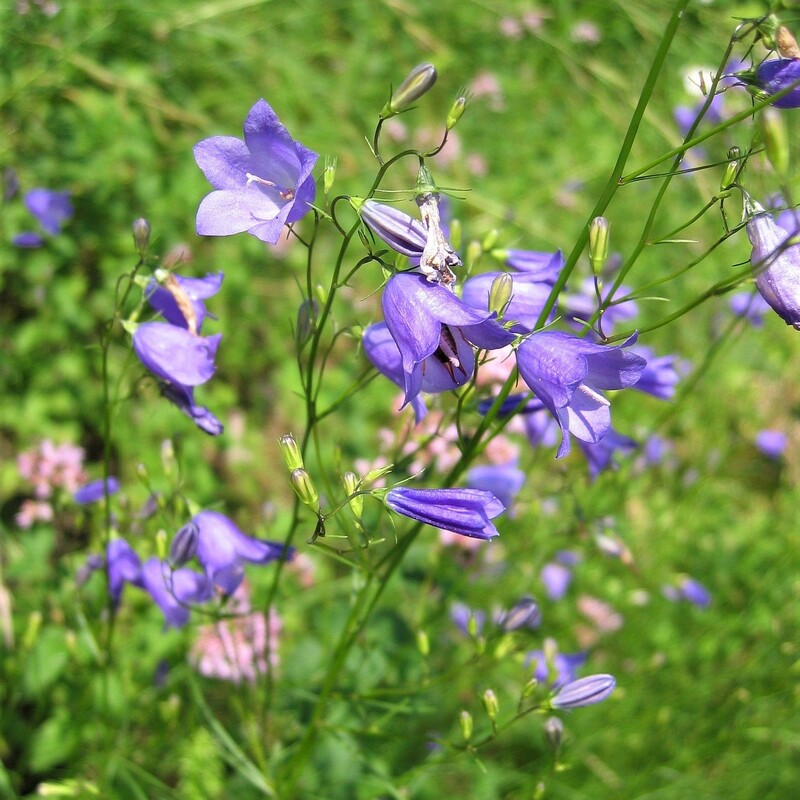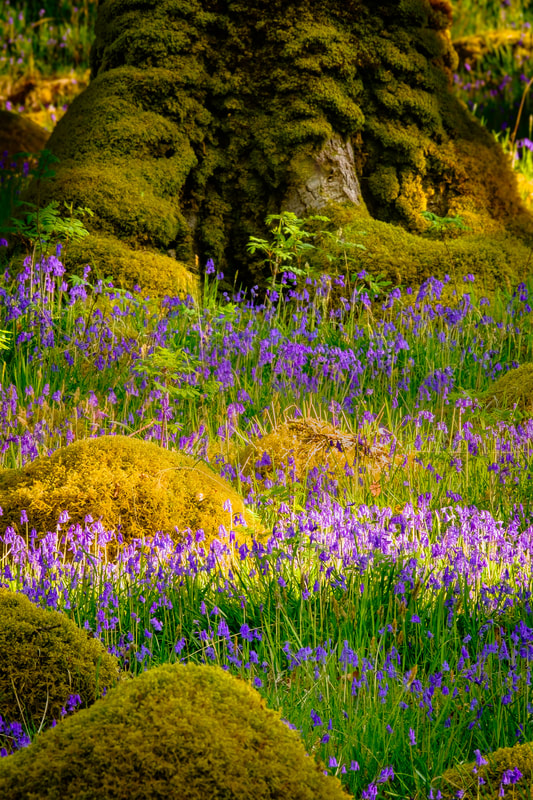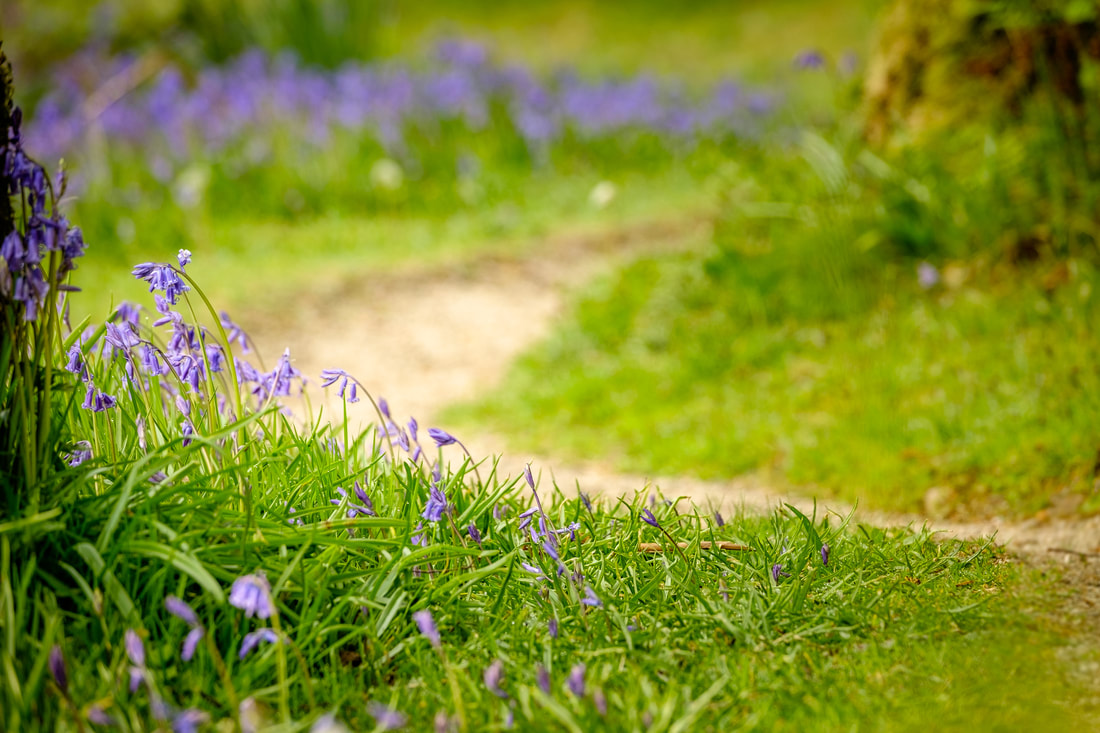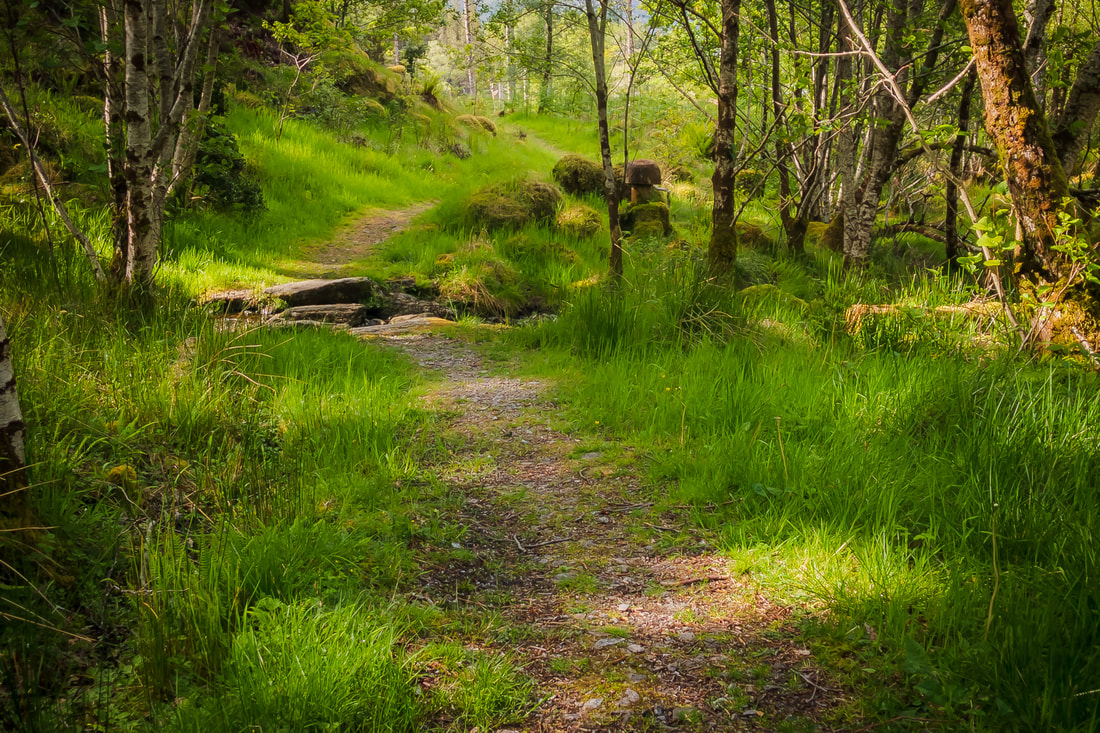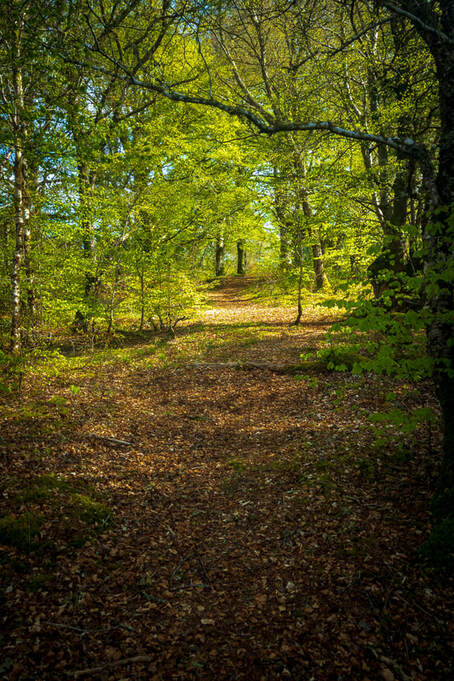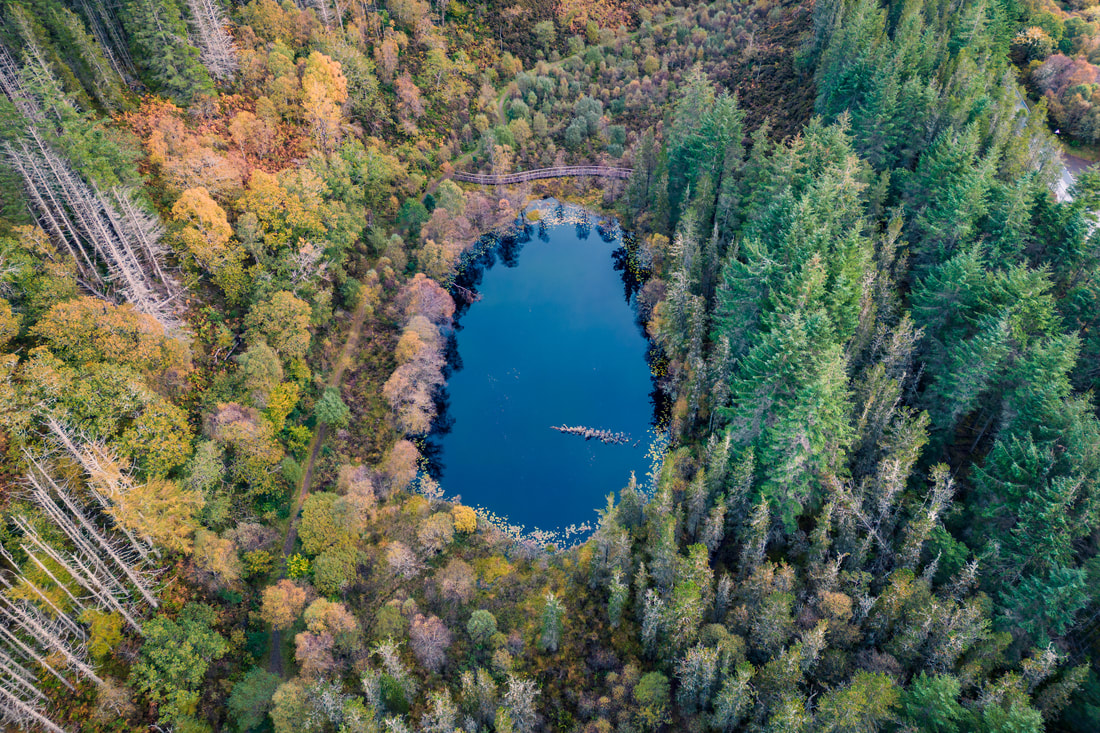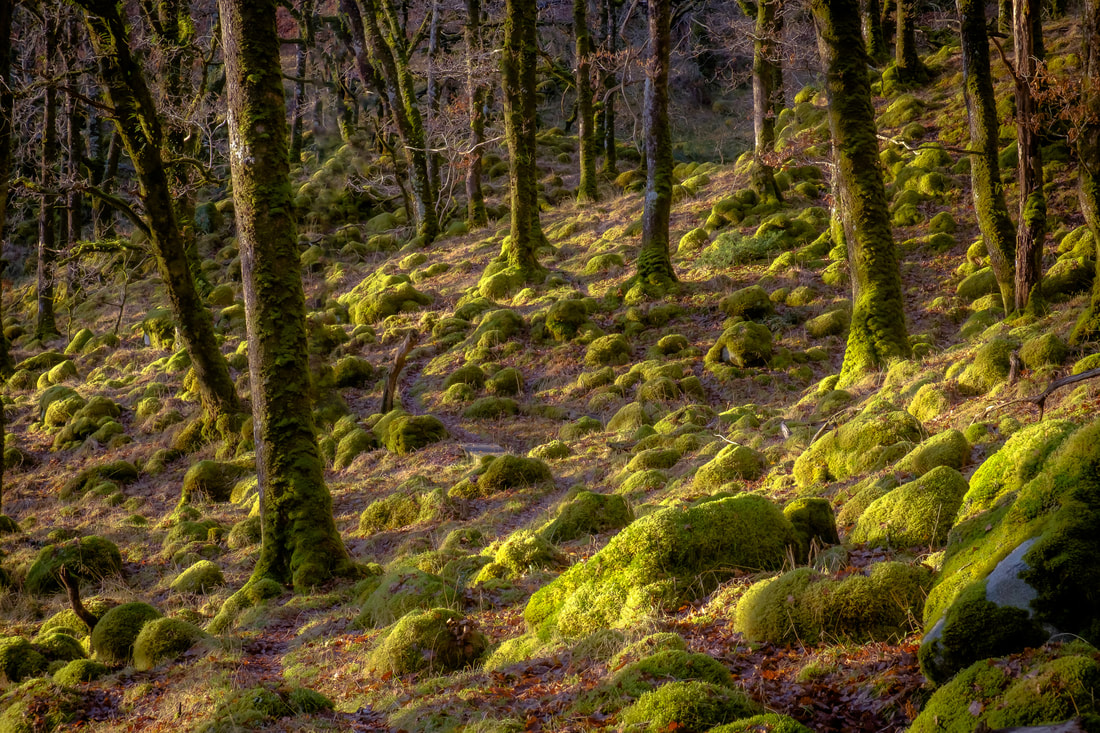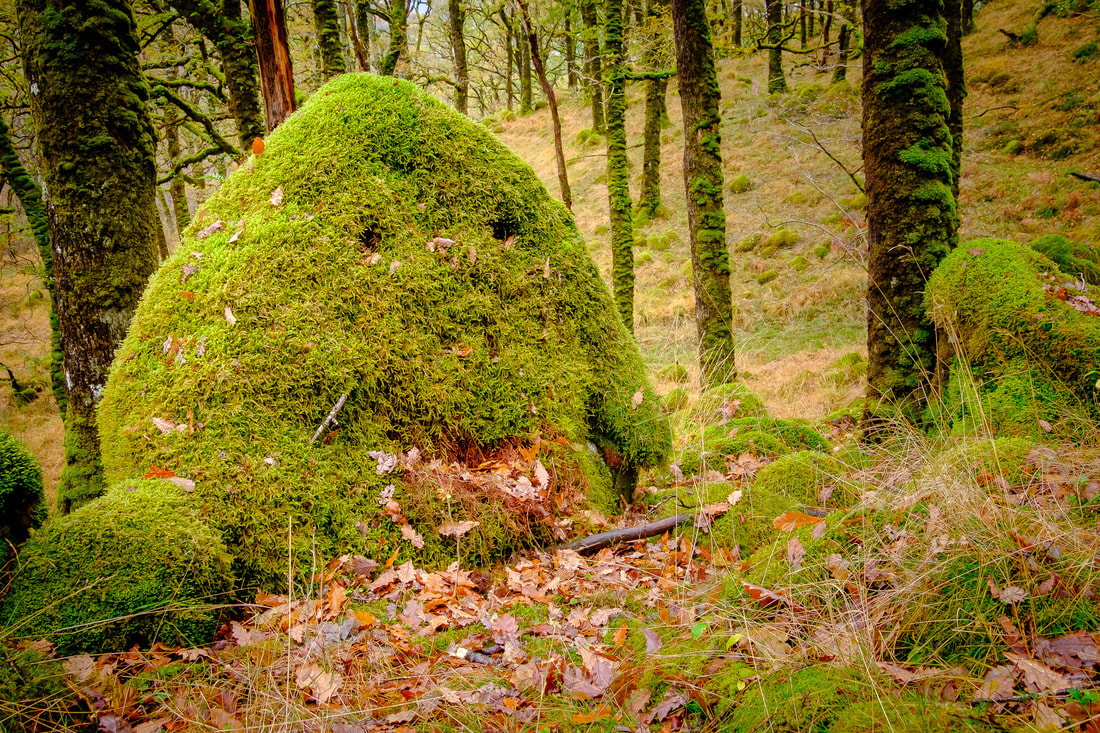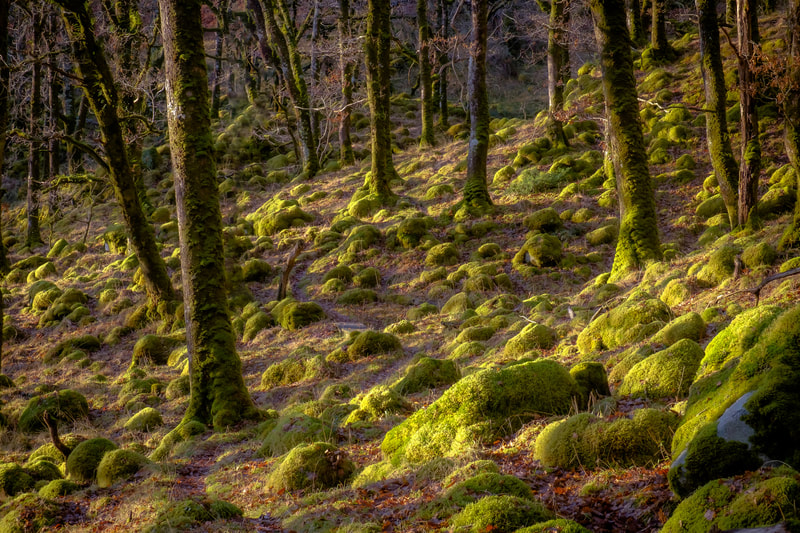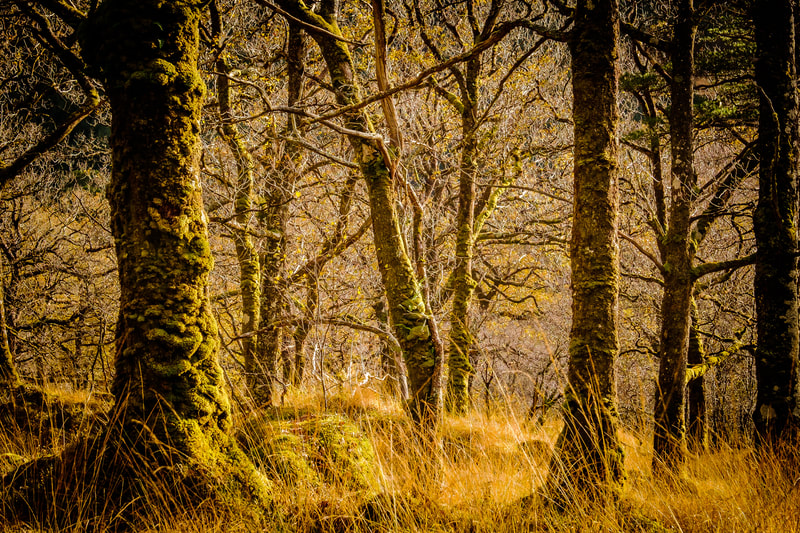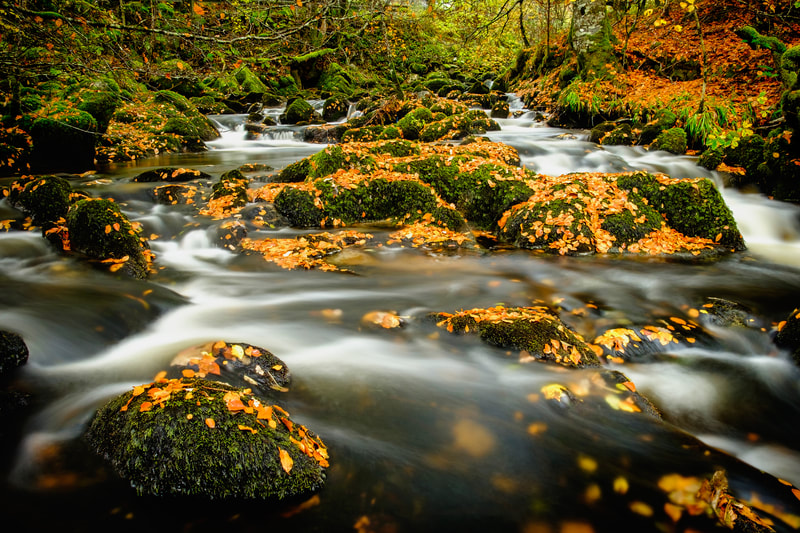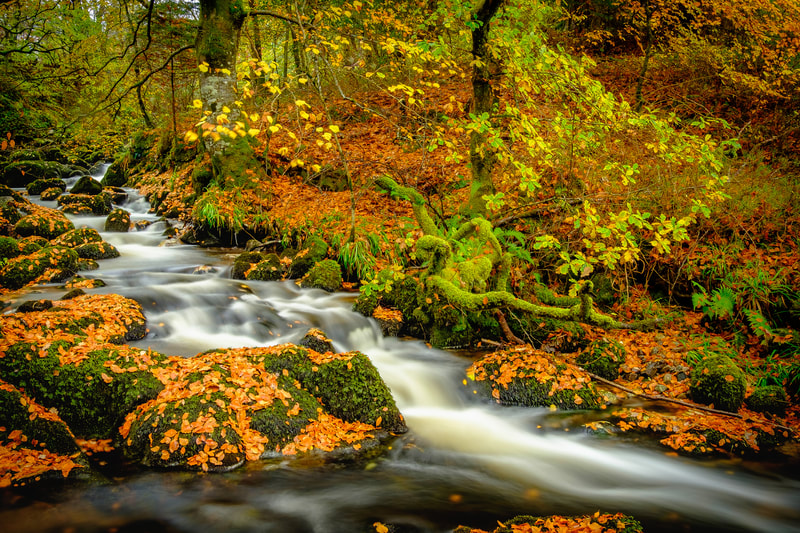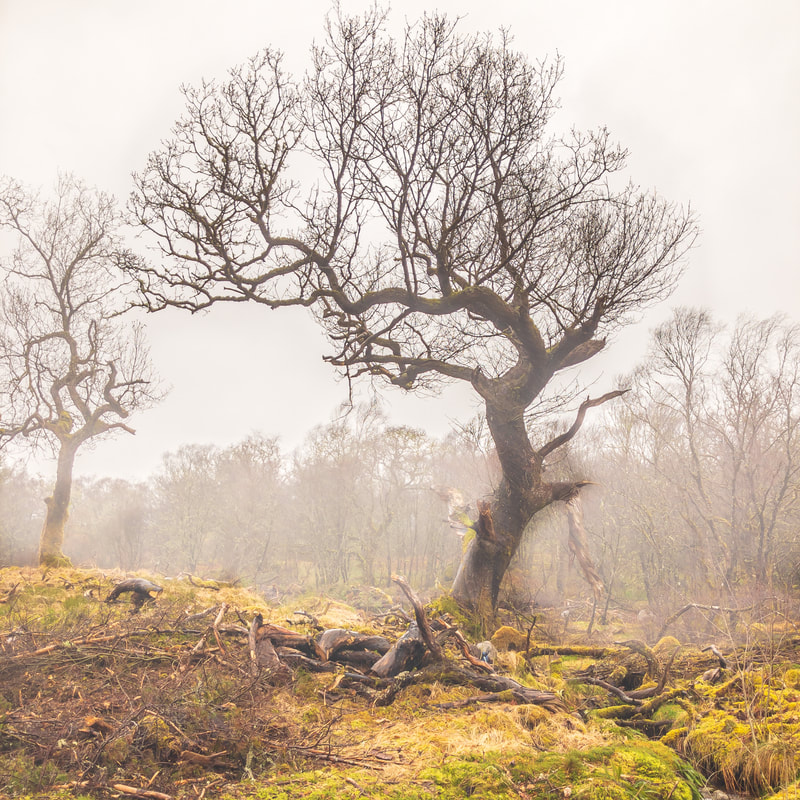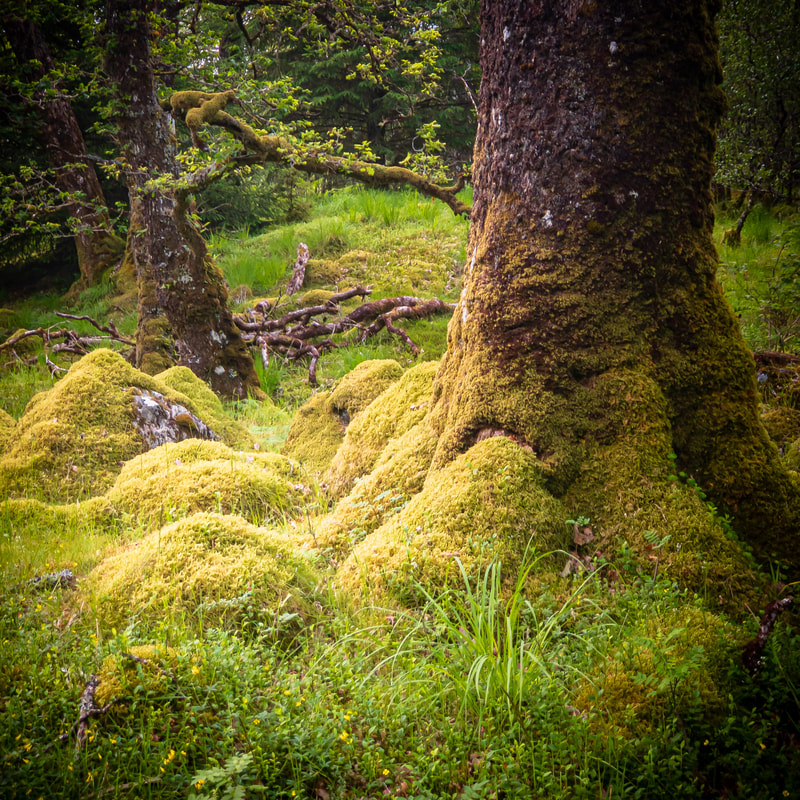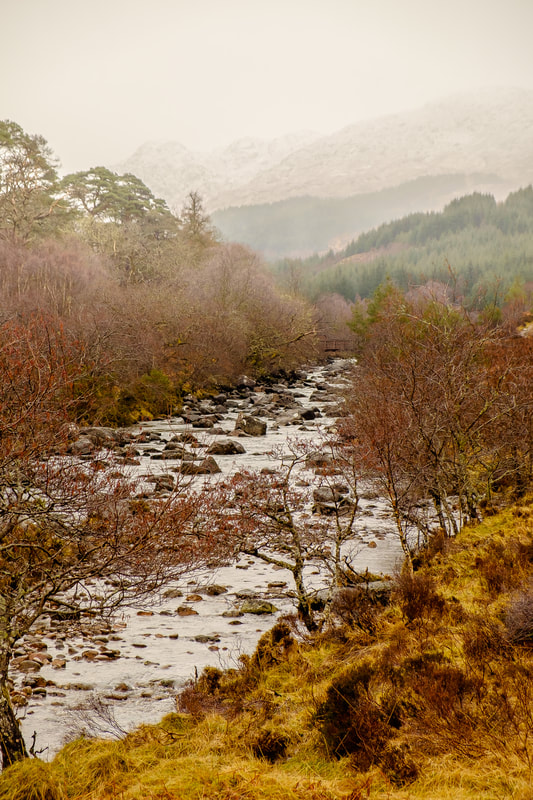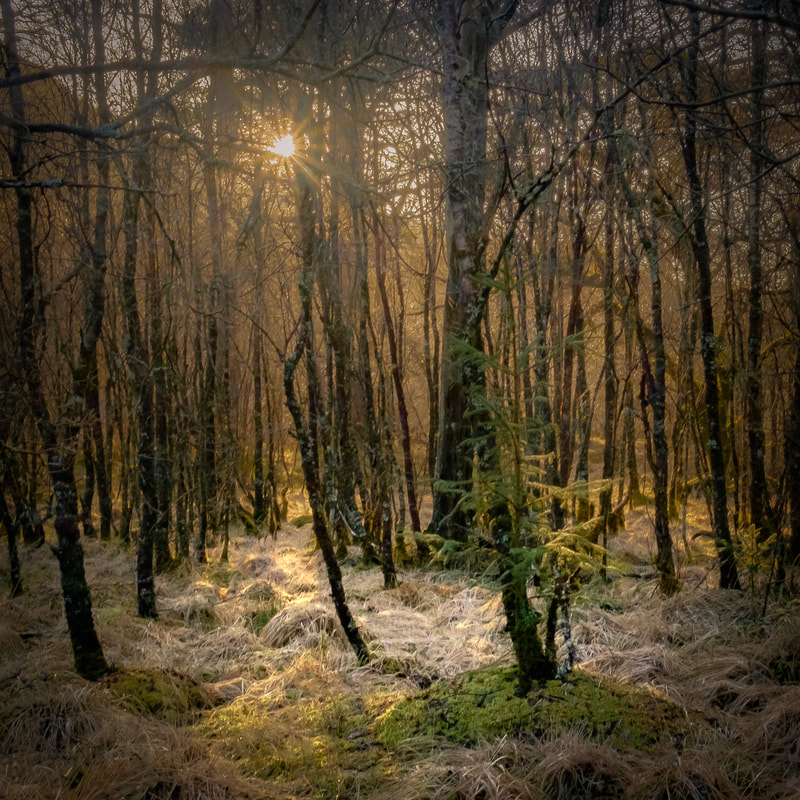|
This month’s thoughts come from a set of six images taken one morning when I decided to explore the boggy ground around the head of Loch Moidart at Ardmolich. I had driven by there the night before on my way to Glenuig and my eye was drawn to a large swathe of cottongrass that covered much of what I could see. This fluffy headed plant is a common sight on the Peninsula from around late May and into midsummer. In many places they are dotted here and there, but occasionally they form more substantial stands such as the one I had spotted and when they do, they are well worth photographing. Despite its appearance, cottongrass, also known as bog cotton or ghost grass is neither cotton or grass. It is in fact a sedge, which is a group of plants that are closely related to grasses. Three species of cottongrass are likely to be found in Scotland: Hare’s-tail Cottongrass, Common Cottongrass and Broad-leaved Cottongrass. All three love damp, acidic environments so are well at home in the peat filled salt marsh that is at Ardmolich. Hare’s-tail cottongrass has just one ‘cotton’ head at the tip of its stem in the form of a tidy, almost spherical tuft, reminiscent of the tail of a rabbit or hare, hence the name. On the other hand, broad-leaved cottongrass and common cottongrass both have several and more unkempt ‘cotton’ heads drooping from their stems that look a bit like cotton wool that has been pulled apart. Having looked at the plants I was photographing, I decided that they were common cottongrass because of the narrow leaves and stems that they had. I wandered around the salt marsh, carefully making my way around innumerable water pools and across countless tussocks until I found myself in the middle of a sea of white, fluffy seed heads gently swaying in the slight morning breeze. I knelt down to take a closer look at the tufts of ‘cotton’ and found myself with an eye level view across the top of them to the hills at the other end of Loch Moidart. It was from there that I took my first photograph, using a long focal length to compress and emphasise the sea of white that floated before me. With the wide perspective shot taken, I focused my time on taking a series of shots that captured the cotton grass in more detail, eventually homing in on a single plant that I was able to isolate from all the others around it by using careful composition and a wide aperture. Coming to the end of doing this, I began to wonder if this fluffy, delicate plant had been used for anything in the past and if it had any folklore associated with it.
Unsurprisingly, one of the primary historic uses of cottongrass was as a stuffing material, particularly by rural communities where resources were limited, and every available material was put to good use. I found references to its downy fibres being used as an insulating stuffing for pillows, mattresses, for lining shoes and even as an absorbent pad for infants to use at night instead of a nappy. When it comes to Scottish folklore, one common theme appears to be the association of cottongrass with the faeries. A number of tales describe cottongrass as one of their favourite plants because they used the soft, fluffy tufts to make their beds, while other tales have described patches of cotton grass swaying gently in the wind as the sight of faeries dancing. However, it is in Shetland where the clearest association of cottongrass and mystical beings exists. It is known locally as Lucka Minnie’s Oo, or wool. A witch from Shetland folklore, Lucka Minnie, was said to roam the hills in summer to collect this wool, which she’d process on a card obtained from the faeries and then use it to knit her clothes. When I tried to find out a bit more about her, I came across two conflicting stories. One described her as a fearful ‘trow’ or troll who met her end while chasing after a young boy who she’d intended to eat for her dinner. The other painted her as a rather benevolent character who would guide lost travellers through treacherous boglands by revealing paths marked by distinctive clumps of cottongrass. I guess that if one were to be true, I hope it would be the latter, which I think would be a fitting tale to link with the delicately beautiful tufts that are the seed heads of the cottongrass.
0 Comments
Despite June being colder than normal, the greening up of the landscape we saw in May was followed by a profusion of wildflowers coming in to bloom to cover the landscape with a multitude of bright colours. This year, it seemed to me that the most prominent amongst them has been the foxglove, with its tall purple spire of bell shape flowers often found rising above dense blankets of bracken that cover the ground from late May onwards. Their size and colour make them visually striking plants and a pair that I found out at Dorlin one morning provided me with the ideal subject on which to anchor this shot of Castle Tioram. While foxgloves, scientifically known as Digitalis purpurea, are undoubtedly striking plants, they are renowned for their potent medicinal properties and have played a key role in treating heart conditions. In the late 18th century, the English physician William Withering discovered that digitalis, an extract from the foxglove, contained digitoxin and digoxin. These two compounds help strengthen and regulate the force of the heart contractions and have been used to treat irregular heartbeats and manage the symptoms of heart failure. In the past, digitalis has had other medicinal uses and was listed in Nicholas Culpeper’s 1652 herbal medicine guide, The English Physician, as a treatment for “the falling sickness”, or epilepsy. One famous person who may have been treated with digitalis for epileptic seizures was Vincent Van Gogh. Many art historians believe that the yellow haze that this would cause in the sight of patients receiving this type of treatment may be responsible for his “yellow period”. This was a time when yellow dominated many of his paintings, and particularly The Starry Night, a painting in which a yellow corona surrounded the moon and each star in it. When it comes to folklore, views are divided on where the common name for Digitalis purpurea comes from. In some parts of Scotland, there is a strong association between the plant and faeries, with foxglove seeming to be a corruption of “folksglove” thus implying that the flowers were the gloves of faeries. In this context it is believed that these gloves are worn by these mystical beings to help them avoid leaving fingerprints when meddling in human affairs. Another myth tells of the foxglove’s bell-shaped flowers being used as little hats or homes by faeries, with children often warned against picking them to avoid offending the fairies who might live inside them and to not bring misfortune upon themselves. Foxgloves were also thought to have protective properties and hanging a sprig of foxglove outside a house was believed to ward off evil spirits and protect the inhabitants from harm. While in some areas, foxgloves were planted around homes and barns to safeguard against witchcraft and to ensure the health and safety of livestock. Alternative folklore suggest that the name “foxglove” comes from the idea that the flowers are the right size and shape for foxes to wear on their paws. According to this legend, foxes, known for their slyness and stealth, would put the flowers over their paws to muffle their footsteps as they hunted or avoided predators. This idea not only highlighted the fox’s cunning nature but also lent an almost magical quality to the foxglove plant, suggesting that it provided some supernatural aid to these clever animals.
As I write this, we are about halfway through meteorological Spring and the recent cold and wet weather seems to have delayed the awakening of the landscape from its winter slumber. The dawn chorus has not yet filled the early morning air with birdsong and the spring flowers are only just beginning to cover the ground with the usual multitude of bright colours. However, as April turns into May, I’m hopeful that I’ll soon hear my first cuckoo, whose distinctive call well and truly heralds the arrival of spring, just as it did when I was out at Smirisary on a beautiful mid-spring evening and captured the image below. In my mind, the cuckoo is one of the most iconic migratory birds to visit us each year. Its distinctive "cuck-oo" or "coo-coo" call resonates through misty mornings and still evenings, carrying promises of warmer days and the vibrant rebirth of flora and fauna. In addition to this, the bird itself is intertwined with various superstitions and legends.
One prevalent belief is that the timing of the cuckoo's arrival can predict the weather for the upcoming season. If the cuckoo is heard early in the spring, it was said to foretell a warm and prosperous summer ahead. Conversely, a late arrival was thought to signal a cold and harsh season, causing anxiety among farmers and villagers who relied on favourable weather for their livelihoods. The cuckoo's association with prophecy extends beyond meteorological predictions and into matters of love and luck. In some Scottish communities, it was believed that hearing the first call of the cuckoo could bring fortune to couples seeking to conceive a child. Newlyweds would eagerly await the arrival of the cuckoo, hoping that its call would bless their union with fertility and abundance. However, not all superstitions surrounding the cuckoo were benign. In certain folklore traditions, the cuckoo was viewed with suspicion and even fear, often being portrayed as a symbol of deceit and trickery. One particularly ominous belief is the notion of the "cuckoo's curse," which suggests that hearing the bird's call on certain days, especially Sundays or while in bed, could bring misfortune or even death to the listener or their family. The mysterious nature of the cuckoo is further accentuated by its peculiar habits, including its brood parasitism behaviour. Unlike most birds, which build nests and care for their young, the cuckoo lays its eggs in the nests of other bird species, relying on them to raise its offspring. This behaviour has led to the cuckoo being associated with themes of deception and betrayal in folklore, because it exploits the labour and resources of unwitting foster parents. Beyond its cultural significance, the cuckoo's presence also serves as a barometer of ecological health, reflecting the condition of its breeding habitat and the availability of its preferred food sources. Concerns about habitat loss, climate change, and the decline of insect populations have led to conservation efforts aimed at preserving and restoring the cuckoo's habitat. They include protecting vital breeding grounds, restoring degraded ecosystems, and raising awareness about the importance of migratory birds. Despite these efforts, the cuckoo faces an uncertain future in Scotland. Like many migratory birds, it must navigate a perilous journey here which is fraught with challenges, while avoiding predation and dealing with climate-induced disruptions in food availability. In addition, its dependence on other species, such as the reed warbler and meadow pipit, for egg incubation and chick rearing further complicates its conservation. Yet, amidst these challenges, there is cause for hope. The resilience of the cuckoo, coupled with the dedication of conservationists and the support of local communities, offers a glimmer of optimism for its continued survival. By fostering greater awareness, understanding, and appreciation for this charismatic bird the conservationists hope that they can ensure that future generations will be able to delight in the timeless spectacle of the cuckoo's arrival in a Scottish spring. I, for one, hope that they succeed. Have you ever found yourself wandering in a place where you feel as if you are walking a fine line between this world and another? I ask because it is a feeling I often have when walking among the ancient oaks and between the moss-covered boulders of Ariundle Oakwood. I don’t know what it is about the place, but I feel that I am never too far away from the mystical realm inhabited by the faeries that gives the nearby village of Strontian or Sròn an t-Sìthein (nose of the fairy hill) its name. In my mind, it is one of the “thin places” that can be found here on the Peninsula. The concept of “thin places” has been woven into the tapestry of Celtic folklore and spirituality for centuries, being used to describe places where the boundary between the physical world and a mystical, historical or spiritual world is believed to be exceptionally thin, thus facilitating a sense of connection between the two.
In thin places, you might feel a sense of awe and heightened awareness of being in the presence of something greater than yourself and, as such, they are often characterised by an otherworldly atmosphere, where the ordinary and the extraordinary intermingle. This is certainly something I can say about Ariundle Oakwood, a place where each ancient tree and each moss-covered boulder seems to harbour mystical beings waiting to be unveiled. When you stand in a thin place you may instead find your imagination ignited by thoughts of what has been before you. This historical imagination can transport you to a different era, picturing scenes from the past as if they were unfolding right before your eyes. Camas nan Geall is a place where I get this feeling. This “Bay of the Strangers” is a fascinating place because it contains evidence of human presence that covers a period of several millennia of human history. This ranges from a Neolithic chambered cairn to deserted clearance dwellings and includes a number of things in-between. The chambered cairn in the centre of the bay may seem quite innocuous, but when you stand next to it and consider that people buried their dead there some 5000-6000 years before, you cannot help but feel a sense of what has gone before. Perhaps more poignant though, are the ruins of Torr na Mòine up on the slopes of Ben Hiant which was the settlement that was the home to the people of Camas Nan Geall before they were forcibly evicted in the 18th century so that the land could be used for a sheep farm. It’s hard to comprehend the hardship and trauma that these people suffered from being suddenly cleared from their ancestral lands by the landowner for primarily economic reasons. Finally, the Old Parish Church in Kilchoan is a place where I feel that there is a thin veil between our physical world and the spiritual world. It is a hauntingly peaceful place that seems to compel you to tread carefully and with due deference to ground that has played host to a place of worship from some 700 years. Giving Kilchoan its name, this Church of St Comghan must have been incredibly important to the local community as a place where they could come together not only to worship but to also seek fellowship and support. Indeed, a walk around the graveyard that surrounds the church to look at gravestones that date from as far back as the 14th century and as recent as the 1990’s, pays testament to just how long this “thin place” has provided spiritual succour to the community. There are many other places on the Peninsula to which I have felt a sense of the mystical, historical or spiritual and this most likely stems from my photography encouraging me to slow down and take time to get a real sense of a place before I ever think of pressing the shutter button. However, you don’t need a camera to experience the profound ways in which certain locations can inspire feelings of connectivity to a different realm. You can just slow down, look, listen and feel when you next find yourself in a place that you sense you might be connected to. I took the image below at the end of an August day when sitting above the old crofting settlement of Smirisary situated just to the west of Glenuig. It is a place that is blessed with a fantastic view of the Small Isles of Eigg and Rùm and a place that is perfect for watching the Sun go down at this time of the year. After the harsh light of Summer, I find that the light softens as we get into August and sunsets become longer and more dramatic. It is this that drew me to Smirisary on that evening, but as I sat there watching that “perfect sunset”, I had no idea that August was also the perfect month for “tying the knot”. As well as being a month of beautiful sunsets, August has traditionally held a special place for those that work the land. As the crops ripened and fields were abundant with the fruits of their labour, communities would come together to celebrate and give thanks for the bountiful harvest by holding a harvest festival.
In Scotland, harvest festivals known as Lughnasadh or Lammas were celebrated around the first of August to mark the beginning of the harvest season. Lammas has its roots in ancient Celtic and Pagan traditions and one of the key customs was the cutting of the first sheaf of grain, which was often made into a corn dolly, symbolizing the spirit of the harvest. This corn dolly was usually kept in the home until the following spring when it would be ploughed back into the fields to ensure a good harvest for the next year. Traditionally, Lammas Day Fairs were held across the length and breadth of Scotland and were marked by bonfires, races, dancing and games. ‘Feeing Markets’, where the farm labourers would seek out new employment were often held at these events, but the big attraction was the “Marriage Market” at which people would be handfasted. Handfasting has its roots in Celtic tradition and is the symbolic binding or betrothal of two people. Conducted by a priest, the ceremony itself typically involved a couple holding hands and having them bound together with cords, ribbons, or a ceremonial cloth while they made their vows and commitments to each other. Hence the phrase, “tying the knot”. By “tying the knot”, the couple entered into a period of engagement, or trial marriage. This trial would typically last a year and during this time the couple were encouraged to cohabitate together (and consummate the relationship). After the year was over, they would return to the priest, declare their intent to be wed and be married soon thereafter. If they decided they were not a good match, the couple were allowed to dissolve their hand-fast and became free to choose another suitor and bride. In modern times, handfasting has been adapted and incorporated into various wedding ceremonies as a meaningful and unique ritual. Couples who choose to include handfasting in their weddings often see it as a way to add personal and cultural significance to their union. Reflecting on all of this, I find it fascinating that despite our modern-day year being predominantly based on the Gregorian calendar and Christian holidays, ancient Celtic traditions continue to influence and define significant events and ceremonies in the months of our calendar and our life. My seventh Spring of living here on the Peninsulas has come to an end and I find myself reflecting on something that never ceases to mesmerise me during late May and early June each year. It is the sight of the delicate blue coloured, bell-shaped flowers of the bluebell creating intense blankets of colour in the woodlands, on the hillsides and along the verges throughout the length and breadth of the Peninsula. However, are these really bluebells I am seeing in this incredible wildflower spectacle, or are they something else? Well, it seems that these little plants that spend most of the year as bulbs underground in our woodlands and hillsides, are what botanists call ‘wood hyacinths’ or “Hyacinthoides con-scripta” and have been given the common name of “English Bluebell” because their flowers are indeed blue, and they are indeed shaped like a bell. What about the Scottish Bluebell though? Well, do you remember Scottish Bluebell Matches and the delicate blue and bell-shaped flowers on the matchbox? These are completely different from the “blue bells” on the plants in our woodlands. They are in fact “Campanula rotundifolia”, a creeping, rooted perennial that flowers from July to September and more commonly known as the Harebell. It favours dry, grassy places, so you will find it in the dry land around our sandy beaches as opposed to in our damp, shady woodlands. Many English Bluebell tales involve dark fairy magic with bluebell woods being portrayed as scary, forbidding places that should be avoided. For example, if you do enter a bluebell wood, you should never pick or step on a bluebell for fear of breaking a spell that a faerie has hung on one of the flowers. If you do break a faerie spell, they will get extremely upset, seek you out and enchant you in such a way that you would be drawn further into the woods to wander lost for evermore. Folklore says that you also need to be careful with the Scottish Bluebell because its common name is rooted in magic. Some say that the name “Harebell” was given to the flower because witches would turn themselves into hares and hide among them. It may also be the reason why the names Witch's Thimbles and Witch Bells were used for the flowers.
So, there you have it. Hyacinths or Harebells? English Bluebells and Scottish Bluebells? Different plants linked by a common name and a whole lot of myth and legend, both of which you should not damage for fear of being visited by angry faeries, witches or indeed, the Aul’ Man himself.
May is probably the month of the year that I look forward to most because it is the month in which the landscape well and truly awakens from its winter slumber. The dawn chorus fills the early morning air with birdsong, spring flowers cover the ground with a multitude of bright colours and trees burst with new leaves to create beautiful and vibrant sights in our woodlands. So, on bright May mornings while walking at Sàilean nan Cuileag near Salen and Phemie’s Walk near Strontian, I was compelled to capture the scenes shown in the images below because the fresh, bright green colour of the grass on the ground and the leaves on the trees was such a beautiful and vibrant sight. This ‘spring green’ colour is such a potent sign of new life and renewal. So much so, that it’s little wonder that Beltane, an ancient Celtic festival celebrating joy, renewal, and community falls on the first day of May. Beltane marks the beginning of summer in the Northern Hemisphere and is considered one of the four major seasonal Celtic festivals along with Samhain, Imbolc, and Lughnasadh. As well as joy and renewal, Beltane is often associated with fertility, abundance, and growth, and has been celebrated for centuries with feasting, dancing, and bonfires. In ancient times, bonfires would be lit on hilltops to honour the sun and promote fertility. The bonfire would be the centrepiece of the Beltane celebrations, symbolising the return of the sun and the warmth of summer. It was also believed to have protective and purifying powers, and people would jump over the flames or pass through them as a form of ritual cleansing and purification. They would also drive their livestock between the fires, believing that the smoke and ashes would protect them from disease and bring fertility to the animals.
I grew up in a large council estate called Burnfoot. It was built between the 1950s and 1970s and, in the early part of these years, a group of local people decided to revive the Beltane traditions and create a festival that would celebrate community and bring the people of this new housing estate together. Central to the festival was the crowning of a local girl as the Burnfoot Queen who, like the May Queens of the past, was chosen for her character and community spirit, and was considered to be a role model for other young people living on the estate.
I remember the crowning ceremony to be a big occasion. It was attended by a large crowd of locals and visitors and once it had taken place, there would be procession through the estate, with the Burnfoot Queen at its head, on an elaborately decorated float. To the small boy that I was, the parade was a colourful and lively event, featuring floats and displays from local businesses and organisations. So much so, that it would bring together people of all ages and backgrounds to celebrate what was known as the Burnfoot Festival and ultimately the community of Burnfoot. As far as I’m aware, this Festival still takes place and I find it fascinating how this event from my distant childhood memories was a revival of Beltane traditions that can be traced back to pre-Christian times in Scotland. With its ever-changing weather, dramatic landscapes, beautiful lochs and ancient woodlands, the Peninsula often seems to be a magical and mystical place to me and like much of Scotland, legendary stories used to explain the unexplainable and to warn us away from dangerous places, have been carried down through the generations. Indeed, photographing the Peninsula often leads me to uncovering links between legends and its landscape, just as it did when I photographed Loch Sunart one November day. The image above was captured from the upper slopes of Meall Mor, a small peak that sits on the western flank of Ben Resipole. I have been up there many times because it is only a short distance from my house and the modest climb is rewarded with stunning views westwards over Loch Sunart to the Isle of Carna and the hills of Morvern beyond. While taking this photograph, I saw something that I hadn’t noticed before. A small promontory sitting in front of the silhouette of the Isle of Carna, which only caught my eye because it was lit up by rays of light that had broken through the clouds. Curious as to what it was, I did a bit of research when I returned home to find out that this knoll was both the site of a small Iron Age fort called Dùn Ghallain (Fort of the Storm) and the setting of ‘The Swan of Salen’, a mythical tale that seeks to explain why no swans are found on Loch Sunart. It tells of a Chieftain who fell in love with a maiden of low social status. The Chieftain’s mother disapproved of the match and turned the maiden into a swan. The Chieftain, not knowing this, killed the swan while out hunting and was heartbroken to see the swan’s body take the form of his love as it died. Inconsolable, he fell on his own sword, and the bodies of the two are said to lie beneath Dùn Ghallain to this day. It is said that this is why there are no swans on Loch Sunart, making it the perfect example of a tale to explain the unexplainable. If you travel a few miles east from there, you can find a location whose name is linked to a legend that warns you away from danger. It is Lochan nan Dunaich, the ‘Little Loch of Sadness’, where young children were supposedly lured into its waters by a Kelpie and never seen again. Kelpies are said to be water spirits that inhabit many of the rivers and lochs of Scotland. Although usually appearing in the form of a horse, they are capable of shape-shifting and can take human-form. When in horse form a kelpie will often stand near the edge of a river or loch waiting for its prey, which will often be young children. Kelpies have magically adhesive bodies, meaning that should a child choose to clap the supposed horse, they will become attached, allowing the Kelpie to drag its victim into the water and drown them.
It is also said that they can stretch the length of their backs to carry several children to their death at once. One tale involves a group of children, where all but one climbed onto the kelpie’s back while the last child stayed on the shore. This child petted the kelpie’s neck only to have their hand become attached to it. They freed themselves by cutting off the hand only to then watch their friends, who were stuck to the kelpie’s back, being dragged down into the depths of the water where they were devoured, and their entrails thrown to the water’s edge. When you look at Lochan nan Dunaich, a deep and dark pool of water with fallen trees around its boggy edges, you can well understand the need to warn children away from straying too close to it and with such gruesome tales about Kelpies, you can well understand how the local legend would have been to this effect. So, if you find yourself there, tread carefully, very carefully indeed. I took the image below on a beautifully still late summer evening out a Dorlin, just as the sun was dropping behind Eilean Shona and as oystercatchers were returning to the mudflat on the opposite side of the River Shiel to roost. As they did so, their shrill calls, which are so evocative of the beautiful shores of western Scotland, filled the air. It is such a magical sound, and it is little wonder that the oystercatcher, and its call, features so much in the folklore of the West Highlands and Islands Alasdair Alpin MacGregor, in his book “The Peat Fire Flame” describes how it was related in the Islands that, when Christ was being pursued from one Hebridean Isle to another, he was hidden at low tide by two oystercatchers, who covered Him with seaweed, and kept watch over Him until His enemies had passed. And that it is supposed that for this act of grace, the oystercatcher was chosen to be the gille or manservant of Saint Bridget, Christ's foster-mother. Hence the origin of gille-hridean, the oystercatcher's Gaelic name. An alternative story is that Saint Bride (Bridget) was running away from a band of evil men who were trying to kill her and, after being chased to a beach where there was no place to hide, she prayed to God to thank him for her life and lay on the sand to accept her death. However, before the men reached the beach, oystercatchers, who were patrolling the shoreline, saw her, recognised that she was in danger and covered her with seaweed, hiding her and saving her life. She blessed the species and since that day the oystercatcher has been the brìdean (Brìd-eun ‘Bride’s bird) or gille-brìde ‘servant of Bride’. These two very similar stories may well be pure myth, but there is much written about the bird in the folklore of the West Highlands and Islands. Indeed, they say in the Hebrides that the oystercatcher was originally completely black, and that, in recognition of the two oystercatchers saving Christ from His enemies, it was awarded white plumage on its breast causing it to look like a white cross when it is seen flying towards you. However, the oystercatcher’s most distinguishing feature must be its call and, more often than not, you will hear its shrill, insistent peep, peep, peep long before catch sight of any birds. In Gaelic the cry of the oystercatcher is " Bi glic, hi glic ; bi glic, bi glic! ", meaning ' be wise,' ' be prudent,' ' take care.' One story has it that Saint Bride followed this call across the sea from Ireland in her coracle to finally be guided to the shores of South Uist with an oystercatcher on each wrist. She is also said to have been able to call them to her hand and, in rough weather, send them out to sailors to guide them to safety. This may be why the cry of an oystercatcher was commonly regarded by West Highland mariners and fishermen as a warning of an approaching storm. Video: An Oystercatcher Sunset Chorus, Dorlin, Loch Moidart After hearing their call, you may well spot oystercatchers swooping low over the sea, making a dazzling flight pattern, before eventually landing on exposed sand and mud flats, where they feed on shore-dwelling bivalves such as mussels and limpets, along with other invertebrates like ragworms. I just love watching these gregarious and noisy birds as they quickly run up and down the tideline in an almost comical fashion. To watch this flurry of activity and boundless energy helps you understand why one of the collective nouns for the oystercatcher is a “stew”. The two others I’m aware of are “Rockefeller” and “parcel”, but they just don’t seem to fit the bill as well.
It’s June and summer is finally upon us. This means milder weather and longer days, with the longest day of all taking place on 21 June, the day of the Summer Solstice. As the Sun sets so late and rises so early, it barely gets dark at this time of year. Indeed, this month’s image, which was taken shortly before 11:00 pm on a night close to the Summer Solstice, shows just how light it can be. I spent quite some time then, sitting on a small promontory facing west over Loch Sunart and watching the slimmest of crescent moons traverse the twilit sky as midnight approached. There sure is something magical about these light nights and it is little wonder that the summer solstice and midsummer have been celebrated for time immemorial This year, the summer solstice occurs on 21 June at 10:13 am. It is the exact moment when the North Pole is at its maximum tilt towards the Sun, when the Sun reaches its highest position in the sky and when the Sun rises at its closest to north-east and sets at its closest to north-west.
Although the summer solstice is a precise moment in time, many people refer to it as the “Longest Day” because it is the day when the number of hours of daylight are at their maximum and the number of hours of night are at their minimum. For instance, on 21 June this year, our sunrise here on the Peninsula will be at 4:27:36 am and our sunset will be at 10:22:23 pm, giving us 17 hours, 54 minutes and 47 seconds of daylight. While the summer solstice marks the astronomical start of our summer, it has traditionally been celebrated in Scotland as midsummer, the halfway point in the growing season and a time when people hoped for bountiful harvests. The celebrations began as a Celtic fire festival when bonfires would be used to bless crops and beasts. Animals would be walked around the fire in a sun-wise (clockwise) direction and torches would be lit from the main fire to then be carried around homes and fields, also in a sun-wise direction, to bless families and the crops. Also, people used to gather herbs at this time, and either scatter them into the fire to complete the ritual, wear them along with flowers to ward off evil spirits, or place them under their pillows as good luck charms to manifest good dreams. Birch branches were sometimes hung above doors for protection. This was also believed to be the best time to collect honey from beehives, which is why the first full moon in June was called the “honey moon”. Unsurprisingly, this became the traditional month for weddings. With the coming of Christianity, many pagan midsummer celebrations were moved to the feast of St John the Baptist on 24 June, with bonfires remaining central to them. People would light the bonfires on midsummer eve and then stay up until midnight to welcome in midsummer day. They continued to gather herbs and flowers to protect themselves from evil spirits and one of the most powerful plants was ‘chase-devil’, which is now called St John’s Wort. It was used in potions and woven into garlands because people believed that this would provide them with protection. Finally, herbalists continue to use St John’s Wort in medicines to this day. It contains many chemicals that act on messengers in the brain that regulate mood and there is some strong scientific evidence that it is effective for mild to moderate depression. We are now in May, the last month of Spring and the landscape has well and truly awakened from its winter slumber. The leaves have unfurled on the trees, the wildlife is thriving, and the colourful blooms have appeared. We’ve seen snowdrops in February, wood anemones in March, primroses in April and now it’s time for the carpets of bluebells to appear in the ancient woodlands across the Peninsula. This wildflower spectacle is a magical sight and one that leaves you with a feeling that these woodlands with carpets of blue are indeed enchanted. In Celtic folklore, bluebells have a strong association with spirits and faeries. They are often called faerie flowers and their small bell-shaped flowers are believed summon the faeries when rung. This is not necessarily a good thing because faeries are believed to hang their spells on the bluebells to dry and disturbing them may unleash wild magic upon you, leaving you dazed by enchantment and unable to find your way out of the woods. It can be even more serious for children who pick bluebells because it is believed that they could be snatched away by the faerie folk, never to be seen again.
So, if you do visit a bluebell wood, just remember to stay on the path and to not pick or disturb any of the flowers. Besides risking the wrath of the faeries, another good reason to avoid disturbing them is that they are poisonous, and this might be the reason why there are so many old tales and legends warning people away from them. However, these beautiful little flowers have also been valued for their useful properties and have been used over the centuries by herbalists to prevent nightmares and to treat leprosy, spider bites and tuberculosis. They contain at least 15 biologically active compounds that provide them with protection against insect and animal pests and in recent years, some of these compounds have been investigated as possible treatments for HIV infection and cancer. Bluebells have practical uses as well. They produce an exceptionally sticky sap which was used by our Bronze Age ancestors to make a glue that they use for attaching flights of feathers to their arrows. This glue has also been used for several centuries by bookbinders to make and repair books, while in Tudor times, starch was extracted from crushed bluebell roots and used to stiffen the ruff collars that were very much the fashion back then. Finally, some bluebell folklore gives a positive impression of this beautiful little flower. For example, some believe that by wearing a wreath made of the flowers, the wearer can be compelled to speak only truth while others believe that if you can turn one of the flowers inside out without tearing it, you will eventually win the one you love. I took the following photograph on a late winter afternoon as light fell on some of the hundreds of moss-covered boulders that lie amongst the trees in Ariundle Oakwood near Strontian and couldn’t help being reminded of the faerie mounds where the sídhe are said to live. Read on to find out more about these mythological creatures…. What’s in a Name? If you take a walk through Ariundle Oakwood, you’ll see a woodland floor covered with hundreds of moss-covered boulders which, with a little bit of imagination, could be mistaken for mounds that are home to the mythological sídhe, a supernatural race comparable to the faeries or elves. Indeed, the nearby village of Strontian got its name because of the faeries. In Scottish Gaelic, it is called Sròn an t-Sìthein, which translates as the ‘nose of the fairy hill’ and means a knoll or low round hill inhabited by the sídhe.
Going back to Strontian, or Sròn an t-Sìthein, the term sìthein (pronounced shee-an) often referred to small conical hills with hollow interiors containing an invisible world within which it was believed that faeries coexisted with the world of humans. They were thought to have had a huge influence on how successful the annual harvest would be and if a crop failed it was sometimes thought that someone had violated or upset them. So, before you decide to go walking in the fields or forests by yourself, it is perhaps best if you know a little bit about the various faeries, their significance and how not to upset them. Respect, Honesty and No Green Most important of all is to never let a faerie overhear you calling them faeries as they do not like this. They prefer to be called ‘fair folk’ and are very sensitive creatures, so do not be rude, or you might suffer the consequences. Also, you should always be honest with a faerie as they will know if you have lied to them, and not surprisingly, they don’t take kindly to that either. Finally, wearing the colour ‘green’, is also not advisable, as faeries see this as a colour that belongs to them. There are many different kinds of fairies. Some take on human form, some take the form of creatures, some can fly, and all can appear and disappear at will. Some will fool you with comical antics, some will lure you with beauty and some will just plainly let you know how they feel about a human intrusion. Coming across ‘fair folk’ like Buachailleen, Brownies, Gnomes, the Gruagach, Heather Pixies, Pixies and Seelie Courts can be a very rewarding and magical experience, as most of these faeries enjoy being mischievous, shy and friendly. The same cannot be said for the Ghillie Dhu, Kelpies, Nucklelavees or Fachans. Most of these faeries dislike humans intensely and an encounter with one of them folk could end badly for you. In particular, make sure you avoid the Black Angus or Cù-sìth, which means "faery dog". If this large black dog with yellow eyes and sharp fangs shows itself to you, the legend says that you will die in a fortnight. Belief in the ‘fair folk’ continues to this day, with stories being told in the early twentieth century of unwary humans being lured inside the sìthein at night, only to emerge the following morning and discover that decades had passed in the outside world. Other tales detail the abduction of unbaptised babies, or doomed romances with the fairy folk, and the various ills which befell those who dared to refuse them hospitality. Even as recently as January this year (2020), plans for a fish farm in Loch Pooltiel off the north-west coast of Skye were rejected after campaigners warned that fishermen could be lured to their deaths by Ashrays. Also known as Asrais, these faeries are completely translucent water creatures and are often mistaken for sea ghosts. A group of campaigners called Friends of the Eilean Fhlodaigearraidh Faeries warned that workers' lives could be put at risk by the creatures, who could 'lure them with promises of gold and jewels into the deepest part of the ocean'. It’s not all bad though, because as long as you respect the faeries and stick to the rules how not to upset them, then you should be safe on your walk through the oakwoods. Remember to call them ‘fair folk’, do not be rude or dishonest and finally, don’t wear green. Images of SunartYou will find other images of Ariundle Oakwood and the wider area of Sunart in the Images of Sunart gallery on this website. If you’d like a print of any one of them, please feel free to get in touch. Also get in touch if you’d like to arrange some photography tuition.
|
AuthorHi, Archives
July 2024
Categories
All
|
Steven Marshall Photography, Rockpool House, Resipole, Strontian, Acharacle, PH36 4HX
Telephone: 01967 431 335 | Mobile: 07585 910 058 | Email: [email protected]
Telephone: 01967 431 335 | Mobile: 07585 910 058 | Email: [email protected]
All Images & Text Copyright © 2024 - Steven Marshall - All Rights Reserved







